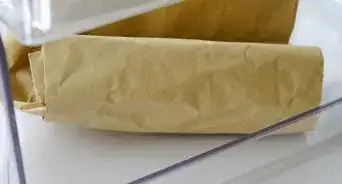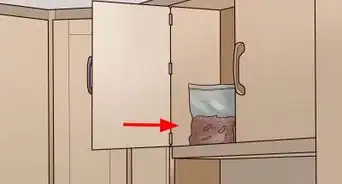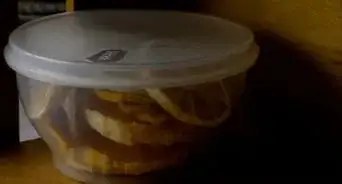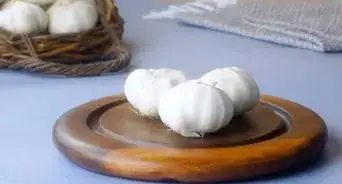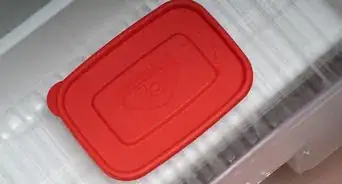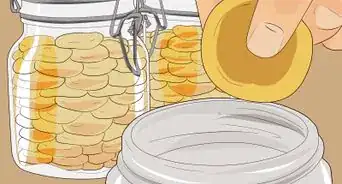This article was co-authored by wikiHow Staff. Our trained team of editors and researchers validate articles for accuracy and comprehensiveness. wikiHow's Content Management Team carefully monitors the work from our editorial staff to ensure that each article is backed by trusted research and meets our high quality standards.
There are 11 references cited in this article, which can be found at the bottom of the page.
The wikiHow Video Team also followed the article's instructions and verified that they work.
This article has been viewed 16,806 times.
Learn more...
Tomatillos have a bright, zippy taste that's sure to add a burst of flavor to any dish. They look a little like green, unripened tomatoes except they have a bright green husk growing around the edible part. Whether you buy them from a grocery store or harvest them in your backyard, you can keep them fresh for longer in the refrigerator or freezer.
Steps
Storing Tomatillos at Room Temperature
-
1Check your harvested tomatillos for ripeness. If you’ve harvested the fruits yourself, you’ll know they’re ripe when the husks start to split or curl open at the bottom. The outside of the husk may also look yellow, reddish, or purple when the fruit is ripe.[1]
- It’s best to harvest tomatillos in the morning hours during mid-summer to fall months.
- Harvest the fruits that show no signs of disease, mold or insect damage.
- The color the husk turns when the fruit is ripened depends on the type of tomatillo you’re growing.
-
2Allow unripe tomatillos to mature in their husks for 1 or 2 days. Tomatillos can be stored on your kitchen counter for up to 2 days if they need some extra time to mature. Make sure to leave the husks on until you’re ready to use them.[2]
- If you plan to use them in the next day or two but they’re very underripe, place them in a paper bag with a fully ripened banana or apple. The gas released from these fruits will speed up the process.
- Don’t put underripe tomatillos in the refrigerator or freezer because it will stop the ripening process and the tomatillo will taste overly tart and acidic.
Advertisement -
3Keep ripe tomatillos on your counter if you’re using them within 2 days. Place the tomatillos on your kitchen counter or in a produce basket if you plan to use them in the next day or 2. Leave the husks on until you’re ready to use them. If they’re already ripe, you don’t have to worry about them going bad in such a short period of time.[3]
- Avoid placing extra-ripe tomatillos in a basket with other fruits that release ethylene gas (like bananas, apples, kiwi, or avocados) because it may overripen the tomatillo.
Refrigerating Tomatillos
-
1Leave the husks on the tomatillos until you’re ready to use them. The husks are in an important part of ripening the tomatillo and keeping it fresh for longer. Removing it may cause the ethylene gas to escape the fruit quicker, making it rot sooner than it would with the husk on.[4]
- If the husk appears shriveled, the tomatillo is over-ripe. You can still eat an over-ripened tomatillo, it just won’t have the same bright, tart flavor.
- While it may cause them to go bad faster, you can peel off the husks first. Just be sure to wash and dry each tomatillo before loosely wrapping them with plastic wrap.
-
2Place fully ripened tomatillos in a paper bag to absorb moisture. Place them in a regular brown paper bag and fold up the top to create a loose seal. The paper bag will help absorb any moisture so your tomatillos stay dry.[5]
- Leaving the husks on the tomatillo will increase their longevity in the refrigerator.
-
3Store the bag in the crisper drawer for up to 3 weeks. Place the bagged tomatillos near the top of the drawer so they don’t accidentally get squished by other, heavier items. If your crisper has adjustable settings, adjust it to the low-moisture setting to allow some of the ethylene gas (released from tomatillos and other fruits) to escape.[6]
- Don't place the bag next to bananas or apples because their natural gases will cause the tomatillos to go bad sooner than they otherwise would.
- The crisper drawer is the perfect place for tomatillos because it keeps high-moisture foods cool and dry.
Freezing Tomatillos
-
1Remove the husk and stem from each tomatillo. Hold the tomatillo with the stem down and peel back each petal-shaped section of the husk. Then twist off the stem like you would an apple.[7]
- You can also soak the tomatillos in a bowl of warm water for 10 minutes to make the husks easier to remove.
- If the stem is too hard to twist off, insert a sharp knife into the top at an angle and cut around the stem until you can lift it away.
-
2Wash the slimy coating off of each fruit and let them dry. Hold each tomatillo under cool running water and rub away the sticky residue with your fingers. Then place them on a paper towel or clean surface to dry.[8]
- It may help to use a vegetable brush to scrub off the sticky coating.
-
3Leave them whole or chop them any way you like. Consider how you plan to use the tomatillos before you freeze them. If you’re going to add them to a stew or make salsa, you may want to chop or puree the tomatillos before you freeze them. That way, you won't have to wait for them to thaw before chopping or pureeing them later on.[9]
- To puree the tomatillos, simply place them into a food processor for 30 to 60 seconds until they take on a chunky, sauce-like consistency.
- To chop the tomatillos, use a sharp chef's knife to cut them in quarters, slivers (like tomato rounds), or smaller diced bits.
-
4Freeze whole or chopped tomatillos in a freezer bag for up to 1 year. If you only have regular plastic zipper bags, double-bag the fruit for more protection. While it's best to use them as soon as you can, frozen tomatillos will stay fresh in the freezer for up to 1 year.[10]
- A heavy-duty freezer bag will preserve the fruit without causing freezer burn (which can cause them to dry and shrivel).
- After you thaw them out to cook, use any leftover thawed tomatillos within 24 hours. You can refrigerate them within that time period but don't refreeze them because they’ll dry out.[11]
Warnings
- Don’t refrigerate the tomatillos in an airtight container because the trapped moisture will cause them to grow mold.[13]⧼thumbs_response⧽
Things You’ll Need
Storing Tomatillos for up to 2 Days
- Ripe (or slightly underripe) tomatillos with husks
- Paper bag (optional, for faster ripening)
- Produce basket (optional)
Refrigerating Tomatillos
- Paper bag
- Crisper drawer
Freezing Tomatillos
- Heavy-duty freezer bag (or 2 regular freezer bags for double-bagging)
- Bowl (optional, for removing husks)
- Warm water (optional, for removing husks)
- Vegetable brush (optional)
- Sharp knife (optional, for removing stem and chopping)
- Clean cutting board (optional, for chopping)
- Food processor (optional, for pureeing)
References
- ↑ https://www.bonappetit.com/test-kitchen/ingredients/article/from-the-market-tomatillos
- ↑ https://www.bonappetit.com/test-kitchen/ingredients/article/from-the-market-tomatillos
- ↑ https://www.seedsavers.org/grow-tomatillo
- ↑ https://whatscookingamerica.net/tomatillos.htm
- ↑ https://www.bonappetit.com/test-kitchen/ingredients/article/from-the-market-tomatillos
- ↑ https://www.seattle.gov/util/cs/groups/public/@spu/@conservation/documents/webcontent/1_037049.pdf
- ↑ https://youtu.be/UPNCuVb-SLU?t=34
- ↑ https://youtu.be/UPNCuVb-SLU?t=37
- ↑ https://youtu.be/FATd1qoX-gI?t=49
